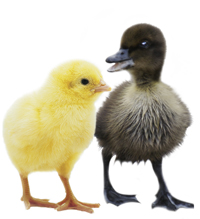2012 Salmonella Hadar Infections Linked to Live Poultry in Backyard Flocks – Consumer Advice
Multistate Outbreak of Human Salmonella Hadar Infections Linked to Live Poultry in Backyard Flocks (Final Update)
Posted October 12, 2012 10:15 AM ET
This outbreak appears to be over. However, Salmonella is an important cause of human illness in the United States. More information about Salmonella, and steps people can take to reduce their risk of infection, can be found on the CDC Salmonella Web Page and the CDC Vital Signs Web Page.

Chick and Duckling
Advice to Consumers
Live poultry can be carrying Salmonella but appear healthy and clean and show no signs of illness. Therefore, you should always follow these recommendations for protecting yourself and others from contact with live poultry:
- Remember that contact with live poultry, including baby or adult birds, can be a source of human Salmonella infections.
- Always wash hands thoroughly with soap and water right after touching live poultry or anything in the area where they live and roam. Adults should supervise hand washing for young children.
Advice to Mail-order Hatcheries and Feed Stores That Sell or Display Live Poultry
- Mail-order hatcheries, agricultural feed stores, and others that sell or display chicks, ducklings and other live poultry should provide health-related information to owners and potential purchasers of these birds prior to the point of purchase. This should include information about the risk of acquiring a Salmonella infection from contact with live poultry.
- Mail-order hatcheries should implement interventions to aid in the prevention of contamination and infection of poultry with Salmonella. Visit USDA’s National Poultry Improvement Plan for more information.
- Agricultural feed stores should implement interventions to prevent human Salmonella infections associated with contact with live poultry.
- An example flyer describing the risk of human Salmonella infections from contact with live poultry and prevention recommendations is available in English [PDF – 1 page] and Spanish [PDF – 1 page].
- More information on displaying animals in public settings can be found in the 2011 Compendium of Measures to Prevent Diseases Associated with Animals in Public Settings [PDF – 28 pages]